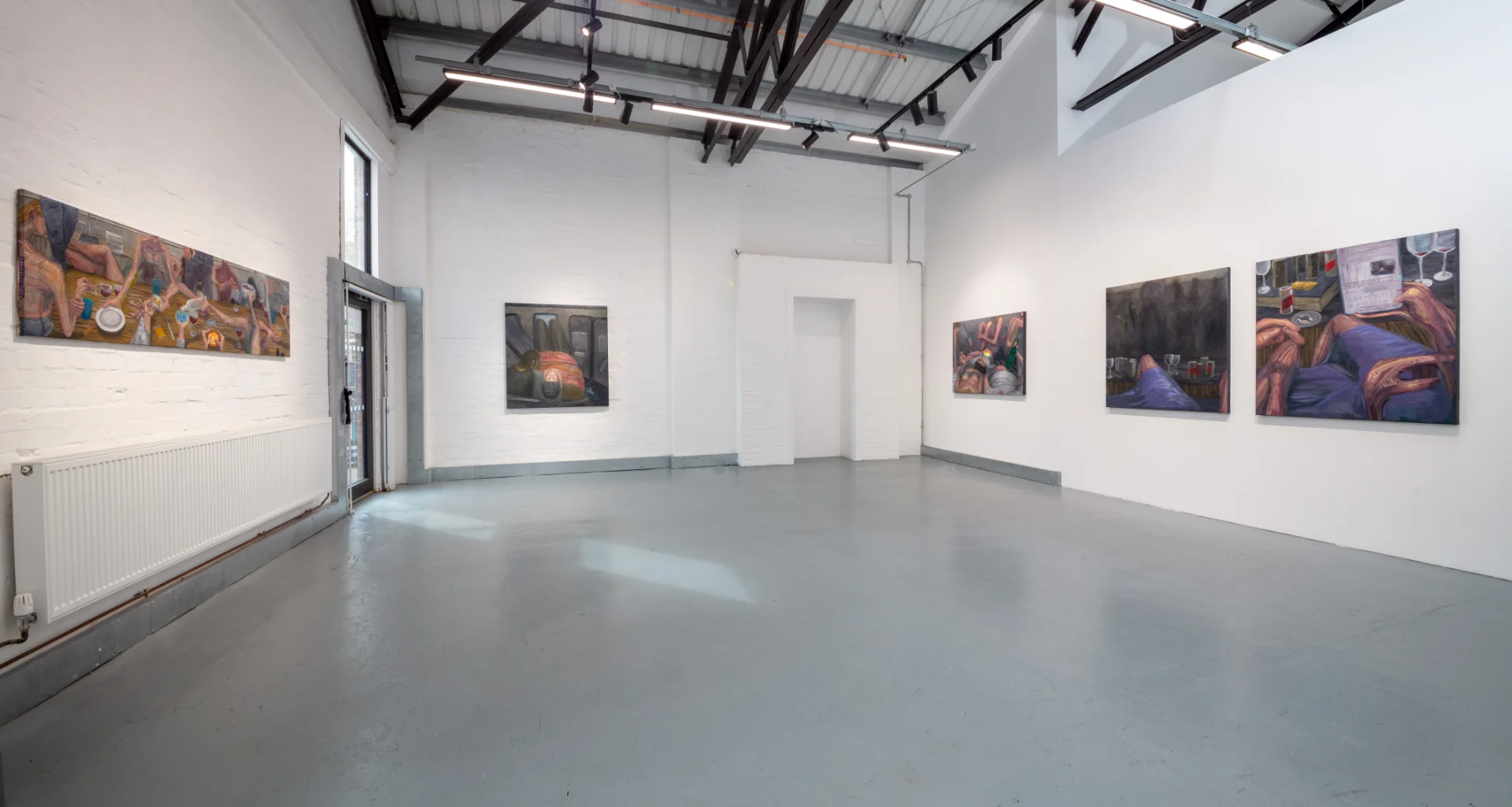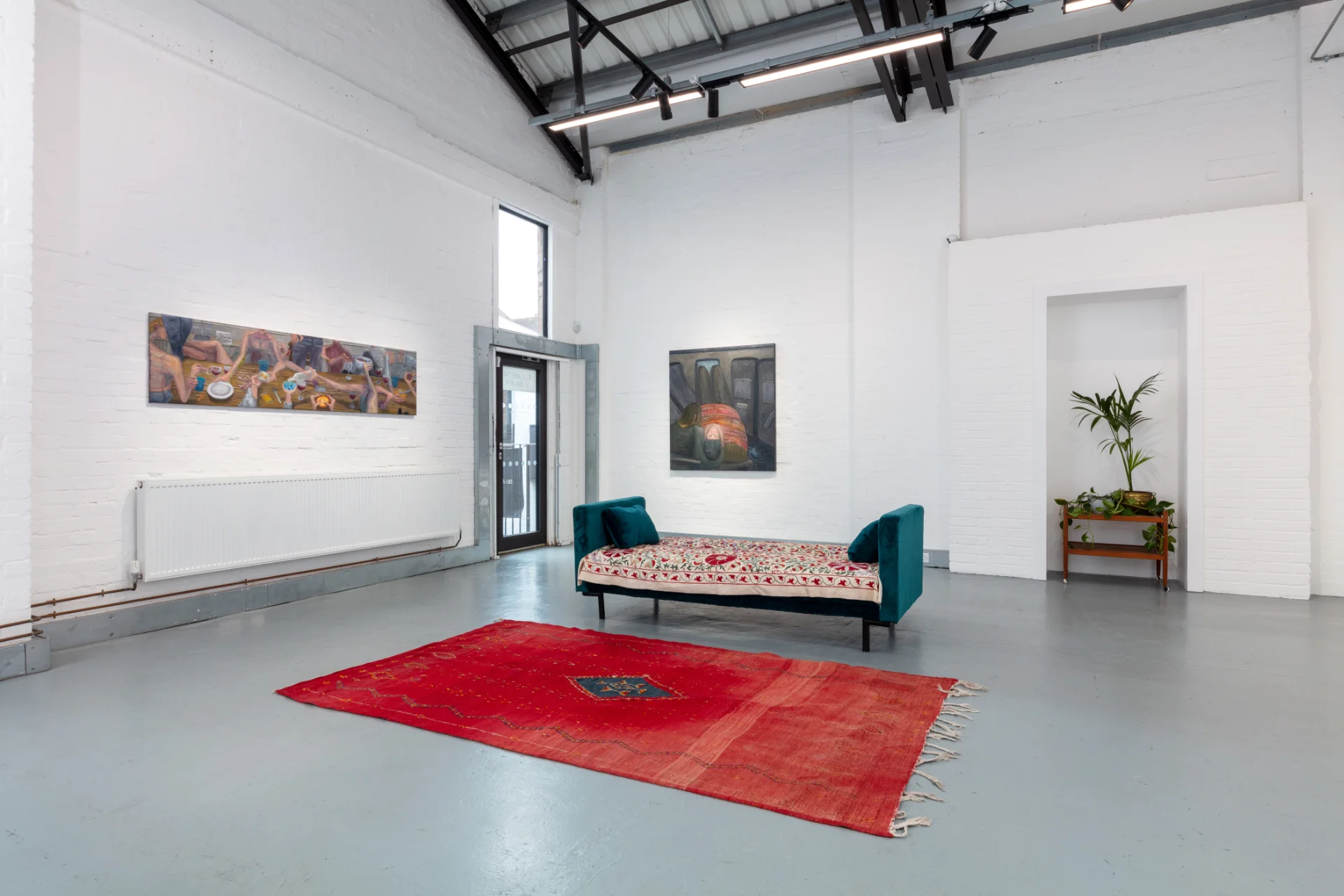Caught in the act of being ourselves
Elizabeth Xi Bauer Presents:
Alexandra Zarins
Caught in the act of being ourselves
12th April – 11th May 2024
Private View: 11th April, 6 – 8pm
Curated by Maria do Carmo M. P. de Pontes
Curatorial text
Alexandra Zarins’ work is rooted in an almost dreamlike realm. Entering her world, we are invited into stories inspired by her own life, observations, and imagination. Caught in the act of being ourselves brings together five new works and a selection of drawings to mark the artist’s first solo show. In Zarins’ pictorial vocabulary, drawings play a similar role to miniature models within a sculptural practice in that they are the first manifestation of a thought, the starting point for her ideas.
Weary Travellers (2024) captures a moment of symbiosis between a couple on a plane. One character lies with his legs bent across the row of chairs while the other cradles his head in her lap, the inherent discomfort of this setting neutralised by the affection embedded within their interaction. Zarins gives an interesting chromatic treatment to the work, exaggerating the greyness of the composition while illuminating the face of the lying figure and the blanket that covers them, gesturing to the chiaroscuro technique, albeit with a twist. This grey and purple palette, disrupted by spells of colour, is characteristic of Zarins’ latest body of work.
Bed Painting (2024) portrays a huddle of bodies, some lying in bed with their heads towards the viewer and some sitting. They drink and smoke, one body curling into the next in a way that conveys an atmosphere of cosiness. It is the in-between moment where nothing really happens but life itself. The painting is illustrative of Zarins’ signature stripe-like brushstroke, which gives the skin a bony texture and the fingers an elongated strange feel. Moreover, it places the works in a dreamlike universe of impossible perspectives.
Wish you were here x (2024) is a diptych that presents one moment seen through different perspectives. One half of the diptych shows two seated figures in the foreground and a few empty glasses and ashtrays placed casually over a table in front of them, suggesting a party. The person on the right holds a phone, where we see an image sent to an unknown receiver together with an about-to-be-sent text reproducing the title of the work – which nods to Pink Floyd’s celebrated song. The second part shows a broader scene, revealing a background of dancing bodies just about visible through the darkness, like shadows, their intimacy emphasising the feeling of displacement of the character with the phone. This half is precisely the image photographed and texted in the first work. The artist explains, ‘The first (half) is the photo that you—as the subject—are sending. You want to capture being here, at this party and share it with someone who’s not there—someone who you wish was. The second is the view from inside—the internal, subjective view, which explores how much more emotion—all the unseen deliberation and anxiety and self-doubt, that is actually tethered to this message’.
Crowd Scene (2024) is a triptych set in a similar nocturnal atmosphere. The viewers see the profiles or the backs of the portrayed characters, suggesting they are collectively watching a performance. Unlike Wish you were here x, Crowd Scene is a continuous image spread across the three canvases – an intentional overlap that is another of Zarins’ visual cues. Whereas there is no intended narrative among the canvases in this exhibition, they pertain to the same pictorial and thematic universe, as if the events were intertwined activities of the same group of people.
While featuring a scene that could address one’s relaxed gathering with friends, Last Supper (2021-2024) further alludes to one of the most famous motifs within Western art history. It is perhaps the composition where Zarins immerses herself the most within an imagined realm, playing with perspectives in ways that make it impossible to assert whether thirteen figures are on the table, more than that or less. Her striated, or sinuous, treatment of the skin is extended to other objects, such as the wooden table and the glasses, creating areas of trompe l’oeil between bodies and objects.





